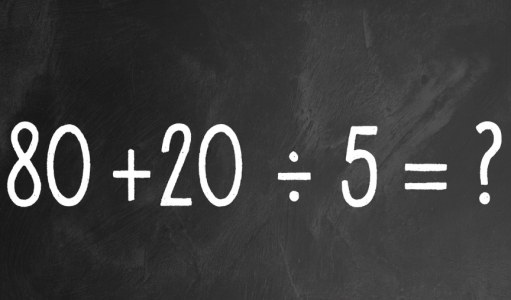Can you solve this quick math puzzle without making the common mistake?
By
Veronica E.
- Replies 2
A short equation is making the rounds online, and it’s catching more people off guard than you might expect.
What looks simple at first glance is causing plenty of disagreement, with answers ranging all over the map.
The debate has grown so intense that it’s starting to feel like the math version of the “blue dress or gold dress” moment.
The problem takes only a few seconds to write down, but solving it correctly depends on remembering a rule many haven’t thought about since school days.
Ready to test your skills and see if you still have it?
The puzzle
The challenge is straightforward: 80 + 20 ÷ 5 = ?
Many people jump right in and come up with completely different answers, from 20 to 320.
The reason? A simple but essential math rule often gets overlooked.
Also read: A man spent days looking—can you solve the bathroom wallet mystery in 20 seconds?
The rule you need: PEMDAS
PEMDAS stands for:
Following this order of operations ensures that no matter who solves the problem, the result is the same.
Also read: This woman can't solve a mysterious cookie cutter—can you?
Step-by-step solution
Also read: Would you dare solve this chilling “numbers clue?” New homeowners uncover an eerie warning hidden in their house
Why people get it wrong
It’s tempting to solve from left to right and add 80 + 20 first, but that changes the math entirely: (80 + 20) ÷ 5 = 100 ÷ 5 = 20
That’s why PEMDAS matters—it’s the standard that keeps calculations consistent in classrooms, business, and everyday life.
Also read: Can you outsmart 98% of people and crack Einstein’s legendary riddle?
Where it shows up in real life
Order of operations isn’t just for puzzles.
You might use it when splitting a bill, adjusting a recipe, figuring medication dosages, or even reviewing tax numbers.
Getting the order right can change the outcome entirely.
Engaging with math problems, crosswords, or logic games helps keep the brain sharp and supports cognitive health as we age.
Plus, it’s a fun conversation starter—whether you’re playing with grandkids or joining an online debate!
Read next: Are you smarter than the internet? Try solving this math puzzle that's baffling everyone online!

Did you solve it correctly? Did PEMDAS come back to you right away, or did you have to think it through? Maybe you have a math trick you swear by or a favorite puzzle that keeps your mind active.
Share your answers and brain boosters in the comments so we can all keep learning—and having fun—together!
What looks simple at first glance is causing plenty of disagreement, with answers ranging all over the map.
The debate has grown so intense that it’s starting to feel like the math version of the “blue dress or gold dress” moment.
The problem takes only a few seconds to write down, but solving it correctly depends on remembering a rule many haven’t thought about since school days.
Ready to test your skills and see if you still have it?
The puzzle
The challenge is straightforward: 80 + 20 ÷ 5 = ?
Many people jump right in and come up with completely different answers, from 20 to 320.
The reason? A simple but essential math rule often gets overlooked.
Also read: A man spent days looking—can you solve the bathroom wallet mystery in 20 seconds?
The rule you need: PEMDAS
PEMDAS stands for:
- Parentheses
- Exponents
- Multiplication and Division (left to right)
- Addition and Subtraction (left to right)
Following this order of operations ensures that no matter who solves the problem, the result is the same.
Also read: This woman can't solve a mysterious cookie cutter—can you?
Step-by-step solution
- Division comes before addition, so:
20 ÷ 5 = 4 - Then add that to 80:
80 + 4 = 84
Also read: Would you dare solve this chilling “numbers clue?” New homeowners uncover an eerie warning hidden in their house
Why people get it wrong
It’s tempting to solve from left to right and add 80 + 20 first, but that changes the math entirely: (80 + 20) ÷ 5 = 100 ÷ 5 = 20
That’s why PEMDAS matters—it’s the standard that keeps calculations consistent in classrooms, business, and everyday life.
Also read: Can you outsmart 98% of people and crack Einstein’s legendary riddle?
Where it shows up in real life
Order of operations isn’t just for puzzles.
You might use it when splitting a bill, adjusting a recipe, figuring medication dosages, or even reviewing tax numbers.
Getting the order right can change the outcome entirely.
Engaging with math problems, crosswords, or logic games helps keep the brain sharp and supports cognitive health as we age.
Plus, it’s a fun conversation starter—whether you’re playing with grandkids or joining an online debate!
Read next: Are you smarter than the internet? Try solving this math puzzle that's baffling everyone online!
Key Takeaways
- A short equation, 80 + 20 ÷ 5, has been circulating widely online, with answers ranging from 20 to 320.
- The confusion comes from forgetting the order of operations, known as PEMDAS.
- Solving correctly means dividing 20 by 5 first to get 4, then adding it to 80 for a final answer of 84.
- Order of operations applies to everyday situations like cooking, budgeting, and calculating medicine doses.
Did you solve it correctly? Did PEMDAS come back to you right away, or did you have to think it through? Maybe you have a math trick you swear by or a favorite puzzle that keeps your mind active.
Share your answers and brain boosters in the comments so we can all keep learning—and having fun—together!








